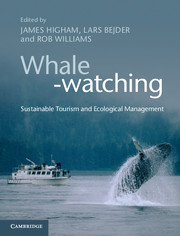Book contents
- Frontmatter
- Dedication
- Contents
- Acknowledgements
- List of contributors
- List of abbreviations
- 1 Tourism, cetaceans and sustainable development
- Part I The historical and contemporary contexts
- Part II Human dimensions of whale-watching
- Part III Ecological dimensions of whale-watching
- 13 Understanding the ecological effects of whale-watching on cetaceans
- 14 Whale-watching and behavioural ecology
- 15 Energetic linkages between short-term and long-term effects of whale-watching disturbance on cetaceans
- 16 Ecological constraints and the propensity for population consequences of whale-watching disturbances
- 17 The use of area–time closures as a tool to manage cetacean-watch tourism
- Part IV Sustainable management: insights and issues
- Index
- Plate Section
- References
16 - Ecological constraints and the propensity for population consequences of whale-watching disturbances
from Part III - Ecological dimensions of whale-watching
Published online by Cambridge University Press: 05 April 2014
- Frontmatter
- Dedication
- Contents
- Acknowledgements
- List of contributors
- List of abbreviations
- 1 Tourism, cetaceans and sustainable development
- Part I The historical and contemporary contexts
- Part II Human dimensions of whale-watching
- Part III Ecological dimensions of whale-watching
- 13 Understanding the ecological effects of whale-watching on cetaceans
- 14 Whale-watching and behavioural ecology
- 15 Energetic linkages between short-term and long-term effects of whale-watching disturbance on cetaceans
- 16 Ecological constraints and the propensity for population consequences of whale-watching disturbances
- 17 The use of area–time closures as a tool to manage cetacean-watch tourism
- Part IV Sustainable management: insights and issues
- Index
- Plate Section
- References
Summary
Introduction
Interactions between boats and cetaceans influence the behaviour of animals. Cetaceans will tend to evade boat interactions and these evasion tactics will lead to altered activity budgets (Williams et al., 2002, 2006; Nowacek et al., 2001, Lusseau, 2003, 2004). In some instances, those influences can have severe impacts for individuals and their populations (Lusseau, 2004, 2005a; Williams et al., 2006; Lusseau et al., 2006; Bejder et al., 2006). However, we currently have no way to determine a priori when boat-interaction effects will lead to biological impacts and when those will have population consequences. This lack of predictive power means that we lack the scientific foundations to manage the current rapid growth of the whale-watching industry and therefore the industry's sustainability is being questioned (Corkeron, 2004; Higham & Lusseau, 2007). In this chapter, I develop a conceptual understanding of how the natural constraints that populations face can be critical factors increasing the propensity for population consequences of whale-watching disturbances. This conceptualization is leading to the development of a number of predictions that I encourage the scientific community to test. Each of these hypotheses is highlighted in their relevant section and I also bring them together in the conclusion.
- Type
- Chapter
- Information
- Whale-watchingSustainable Tourism and Ecological Management, pp. 229 - 241Publisher: Cambridge University PressPrint publication year: 2014
References
- 6
- Cited by

